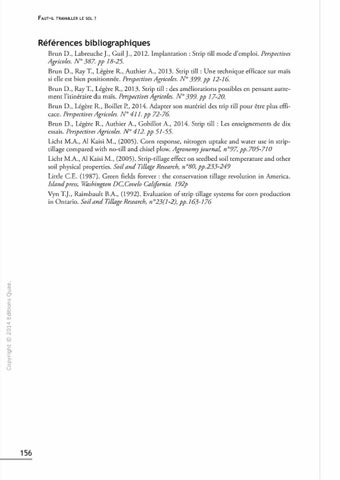F AUT·IL TRAVAILLER
LE SOL ?
Références bibliographiques
Brun D., LabreucheJ., Guil]., 2012. Implantation: Strip till mode d'emploi. Perspectives Agricoles. N° 387 pp 18-25. Brun D., Ray T., Légère R., Authier A., 2013. Strip till : Une technique efficace sur mais si elle est bien positionnée. Perspectives Agricoles. N° 399. pp 12-16 Brun D., RayT., Légère R., 2013. Strip till: des améliorations possibles en pensant autre ment l'itinéraire du maïs. Perspectives Agricoles. N ° 399. pp 17-20. Brun D., Légère R., Baillet P., 2014. Adapter son matériel des trip rill pour être plus effi cace. Perspectives Agricoles. N° 411. pp 72-76 Brun D., Légère R., Authier A., Gobillot A., 2014. Strip till: Les enseignements de dix essais. Perspectives Agricoles. N° 412. pp 51-55. Liche M.A., Al Kaisi M., (2005). Corn response, nirrogen uprake and water use in strip rillage compared with no-rill and chisel plow. Agronomy journal n °97, pp.705-710 Licht M.A., Al Kaisi M., (2005). Strip-tillage effect on seedbed soil temperature and orher soi! physical properties. Soit and Tillage Research, n °80, pp.233-249 Little C.E. (1987). Green fields forever : the conservation tillage revolution in America. Island press, Washington DC, Covelo California. 192p Vyn T.J., Raimbault B.A., (1992). Evaluation of strip tillage systems for corn production in Ontario. Soi! and Tillage Research, n°23{1-2), pp. 163-176
QJ C1J :::J
a l/l C 0
E
"O UJ
�
M 0 N
@
.µ ..c 01
....>-
0. 0
u
156
